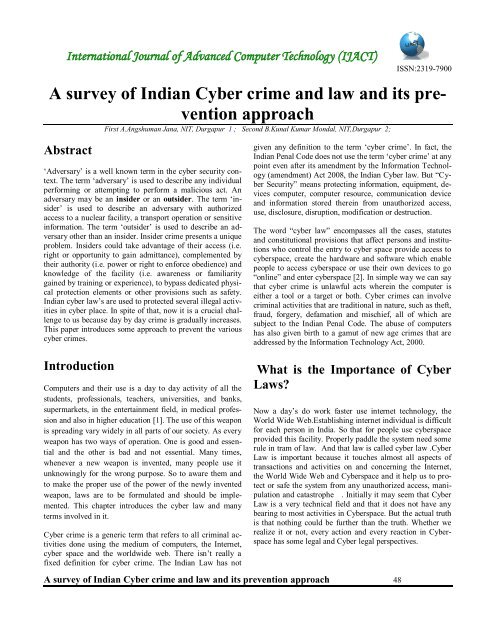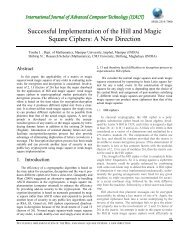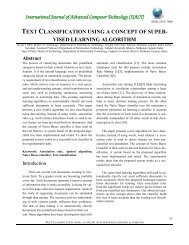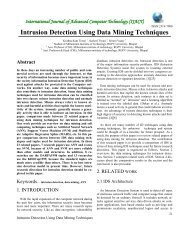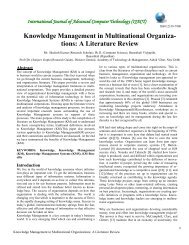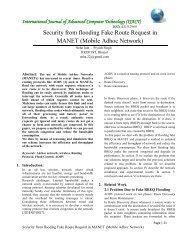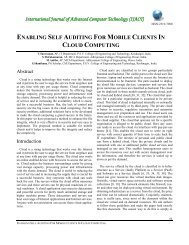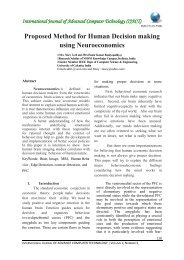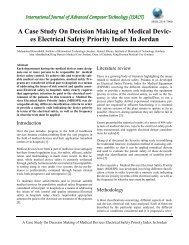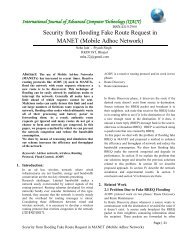A survey of Indian Cyber crime and law and its pre- vention approach
A survey of Indian Cyber crime and law and its pre- vention approach
A survey of Indian Cyber crime and law and its pre- vention approach
Create successful ePaper yourself
Turn your PDF publications into a flip-book with our unique Google optimized e-Paper software.
International Journal <strong>of</strong> Advanced Computer Technology (IJACT)ISSN:2319-7900A <strong>survey</strong> <strong>of</strong> <strong>Indian</strong> <strong>Cyber</strong> <strong>crime</strong> <strong>and</strong> <strong>law</strong> <strong>and</strong> <strong>its</strong> <strong>pre</strong><strong>vention</strong><strong>approach</strong>First A.Angshuman Jana, NIT, Durgapur 1 ; Second B.Kunal Kumar Mondal, NIT,Durgapur 2;Abstract„Adversary‟ is a well known term in the cyber security context.The term „adversary‟ is used to describe any individualperforming or attempting to perform a malicious act. Anadversary may be an insider or an outsider. The term „insider‟is used to describe an adversary with authorizedaccess to a nuclear facility, a transport operation or sensitiveinformation. The term „outsider‟ is used to describe an adversaryother than an insider. Insider <strong>crime</strong> <strong>pre</strong>sents a uniqueproblem. Insiders could take advantage <strong>of</strong> their access (i.e.right or opportunity to gain admittance), complemented bytheir authority (i.e. power or right to enforce obedience) <strong>and</strong>knowledge <strong>of</strong> the facility (i.e. awareness or familiaritygained by training or experience), to bypass dedicated physicalprotection elements or other provisions such as safety.<strong>Indian</strong> cyber <strong>law</strong>‟s are used to protected several illegal activitiesin cyber place. In spite <strong>of</strong> that, now it is a crucial challengeto us because day by day <strong>crime</strong> is gradually increases.This paper introduces some <strong>approach</strong> to <strong>pre</strong>vent the variouscyber <strong>crime</strong>s.given any definition to the term „cyber <strong>crime</strong>‟. In fact, the<strong>Indian</strong> Penal Code does not use the term „cyber <strong>crime</strong>‟ at anypoint even after <strong>its</strong> amendment by the Information Technology(amendment) Act 2008, the <strong>Indian</strong> <strong>Cyber</strong> <strong>law</strong>. But “<strong>Cyber</strong>Security” means protecting information, equipment, devicescomputer, computer resource, communication device<strong>and</strong> information stored therein from unauthorized access,use, disclosure, disruption, modification or destruction.The word “cyber <strong>law</strong>” encompasses all the cases, statutes<strong>and</strong> constitutional provisions that affect persons <strong>and</strong> institutionswho control the entry to cyber space provide access tocyberspace, create the hardware <strong>and</strong> s<strong>of</strong>tware which enablepeople to access cyberspace or use their own devices to go“online” <strong>and</strong> enter cyberspace [2]. In simple way we can saythat cyber <strong>crime</strong> is un<strong>law</strong>ful acts wherein the computer iseither a tool or a target or both. <strong>Cyber</strong> <strong>crime</strong>s can involvecriminal activities that are traditional in nature, such as theft,fraud, forgery, defamation <strong>and</strong> mischief, all <strong>of</strong> which aresubject to the <strong>Indian</strong> Penal Code. The abuse <strong>of</strong> computershas also given birth to a gamut <strong>of</strong> new age <strong>crime</strong>s that areaddressed by the Information Technology Act, 2000.IntroductionComputers <strong>and</strong> their use is a day to day activity <strong>of</strong> all thestudents, pr<strong>of</strong>essionals, teachers, universities, <strong>and</strong> banks,supermarkets, in the entertainment field, in medical pr<strong>of</strong>ession<strong>and</strong> also in higher education [1]. The use <strong>of</strong> this weaponis s<strong>pre</strong>ading vary widely in all parts <strong>of</strong> our society. As everyweapon has two ways <strong>of</strong> operation. One is good <strong>and</strong> essential<strong>and</strong> the other is bad <strong>and</strong> not essential. Many times,whenever a new weapon is invented, many people use itunknowingly for the wrong purpose. So to aware them <strong>and</strong>to make the proper use <strong>of</strong> the power <strong>of</strong> the newly inventedweapon, <strong>law</strong>s are to be formulated <strong>and</strong> should be implemented.This chapter introduces the cyber <strong>law</strong> <strong>and</strong> manyterms involved in it.<strong>Cyber</strong> <strong>crime</strong> is a generic term that refers to all criminal activitiesdone using the medium <strong>of</strong> computers, the Internet,cyber space <strong>and</strong> the worldwide web. There isn‟t really afixed definition for cyber <strong>crime</strong>. The <strong>Indian</strong> Law has notWhat is the Importance <strong>of</strong> <strong>Cyber</strong>Laws?Now a day‟s do work faster use internet technology, theWorld Wide Web.Establishing internet individual is difficultfor each person in India. So that for people use cyberspaceprovided this facility. Properly paddle the system need somerule in tram <strong>of</strong> <strong>law</strong>. And that <strong>law</strong> is called cyber <strong>law</strong> .<strong>Cyber</strong>Law is important because it touches almost all aspects <strong>of</strong>transactions <strong>and</strong> activities on <strong>and</strong> concerning the Internet,the World Wide Web <strong>and</strong> <strong>Cyber</strong>space <strong>and</strong> it help us to protector safe the system from any unauthorized access, manipulation<strong>and</strong> catastrophe . Initially it may seem that <strong>Cyber</strong>Law is a very technical field <strong>and</strong> that it does not have anybearing to most activities in <strong>Cyber</strong>space. But the actual truthis that nothing could be further than the truth. Whether werealize it or not, every action <strong>and</strong> every reaction in <strong>Cyber</strong>spacehas some legal <strong>and</strong> <strong>Cyber</strong> legal perspectives.A <strong>survey</strong> <strong>of</strong> <strong>Indian</strong> <strong>Cyber</strong> <strong>crime</strong> <strong>and</strong> <strong>law</strong> <strong>and</strong> <strong>its</strong> <strong>pre</strong><strong>vention</strong> <strong>approach</strong> 48
International Journal <strong>of</strong> Advanced Computer Technology (IJACT)ISSN:2319-7900Various <strong>Cyber</strong> CrimeComputer <strong>crime</strong>, cyber <strong>crime</strong> [4], e-<strong>crime</strong>, hi-tech <strong>crime</strong> orelectronic <strong>crime</strong> generally refers to criminal activity where acomputer or network is the source, tool, target, or place <strong>of</strong> a<strong>crime</strong>. These categories are not exclusive <strong>and</strong> many activitiescan be characterized as falling in one or more category.Additionally, although the terms computer <strong>crime</strong> or cyber<strong>crime</strong> are more properly restricted to describing criminalactivity in which the computer or network is a necessary part<strong>of</strong> the <strong>crime</strong>, these terms are also sometimes used to includetraditional <strong>crime</strong>s, such as fraud, theft, blackmail, forgery,<strong>and</strong> embezzlement, in which computers or networks are usedto facilitate the illicit activity. Computer <strong>crime</strong> can broadlybe defined as criminal activity involving an informationtechnology infrastructure, including illegal access (unauthorizedaccess), illegal interception (by technical means <strong>of</strong>non-public transmissions <strong>of</strong> computer data to, from or withina computer system), data interference (unauthorized damaging,deletion, deterioration, alteration or sup<strong>pre</strong>ssion <strong>of</strong>computer data), systems interference (interfering with themfunctioning <strong>of</strong> a computer system by inputting, transmitting,damaging, deleting, deteriorating, altering or sup<strong>pre</strong>ssingcomputer data), misuse <strong>of</strong> devices, forgery (ID theft), <strong>and</strong>electronic fraud. Basically above various <strong>crime</strong>s can happenedtwo ways, outside <strong>of</strong> cyberspace or inside <strong>of</strong> cyberspace.to their own account followed by withdrawal <strong>of</strong> money. Byhacking web server taking control on another person‟s websitecalled as web hijacking [6].Trojan AttackThe program that act like something useful but do the thingsthat are quiet damping. The programs <strong>of</strong> this kind are calledas Trojans. The name Trojan horse is popular. Trojans comein two parts, a Client part <strong>and</strong> a Server part. When the victim(unknowingly) runs the server on <strong>its</strong> machine, the attackerwill then use the Client to connect to the Server <strong>and</strong> startusing the trojan.TCP/IP protocol is the usual protocol typeused for communications, but some functions <strong>of</strong> the Trojansuse the UDP protocol as well.Virus <strong>and</strong> Worm attackA program that has capability to infect other programs <strong>and</strong>make copies <strong>of</strong> <strong>its</strong>elf <strong>and</strong> s<strong>pre</strong>ad into other programs iscalled virus. Programs that multiply like viruses but s<strong>pre</strong>adfrom computer to computer are called as worms.E-mail & IRC related <strong>crime</strong>sEmail spo<strong>of</strong>ingEmail spo<strong>of</strong>ing refers to email that appears to have beenoriginated from one source when it was actually sent fromanother source.Technical AspectsTechnological advancements have created new possibilitiesfor criminal activity, in particular the criminal misuse <strong>of</strong>information technologies from inside (direct attack duringsystem access) or outside (indirect attack via internet) <strong>of</strong> thecyberspace such asUnauthorized access & HackingAccess means gaining entry into, instructing or communicatingwith the logical, arithmetical, or memory function resources<strong>of</strong> a computer, computer system or computer network[5]. Unauthorized access would therefore mean anykind <strong>of</strong> access without the permission <strong>of</strong> either the rightfulowner or the person in charge <strong>of</strong> a computer, computer systemor computer network. Every act committed towardsbreaking into a computer <strong>and</strong>/or network is hacking. Hackerswrite or use ready-made computer programs to attack thetarget computer. They possess the desire to destruct <strong>and</strong> theyget the kick out <strong>of</strong> such destruction. Some hackers hack forpersonal monetary gains, such as to stealing the credit cardinformation, transferring money from various bank accountsEmail SpammingEmail "spamming" [7] refers to sending email to thous<strong>and</strong>s<strong>and</strong> thous<strong>and</strong>s <strong>of</strong> users - similar to a chain letter.Sending malicious codes through emailE-mails are used to send viruses, Trojans etc through emailsas an attachment or by sending a link <strong>of</strong> website which onvisiting downloads malicious code.Email bombingE-mail "bombing" is characterized by abusers repeatedlysending an identical email message to a particular address.IRC relatedThree main ways to attack IRC are: "verbal attacks, cloneattacks, <strong>and</strong> flood attacks.Denial <strong>of</strong> Service attacksINTERNATIONAL JOURNAL OF ADVANCED COMPUTER TECHNOLOGY | VOLUME 1, NUMBER 2, 49
International Journal <strong>of</strong> Advanced Computer Technology (IJACT)ISSN:2319-7900Flooding a computer resource with more requests than it canh<strong>and</strong>le. This causes the resource to crash thereby denyingaccess <strong>of</strong> service to authorized users.Examples includeAttempts to "flood" a network, thereby <strong>pre</strong>venting legitimatenetwork traffic attempts to disrupt connections between twomachines, thereby <strong>pre</strong>venting access to a service attempts to<strong>pre</strong>vent a particular individual from accessing a service attemptsto disrupt service to a specific system or person.About insider <strong>crime</strong>We generally focus on insider cyber <strong>crime</strong>. Insider cyberattacks are most dangerous then other attacks because it canhappen any legal access <strong>of</strong> system. Further, as individualshaving authorized access <strong>and</strong> with positions <strong>of</strong> trust, insiderscould be capable <strong>of</strong> defeating methods not available to outsiders.Insiders have more opportunity (i.e. more favorable(conditions) to select the most vulnerable target <strong>and</strong> the besttime to perform or attempt to perform the malicious act.They can extend the malicious act over a long period <strong>of</strong> timeto maximize the likelihood <strong>of</strong> success. This could include,for example, tampering with safety equipment to <strong>pre</strong>pare foran attempt or act <strong>of</strong> sabotage or falsifying accountingrecords to repeatedly steal small amounts <strong>of</strong> nuclear material.In the discussion <strong>of</strong> computer security there should bealways an assumption that we cannot apply those so calledmethods or constraints for the employees within. Thereforethe insider attacks seem to us like unstoppable. But it is nottrue always. Insiders can be stopped, but stopping them is acomplex problem. Insider attacks can only be <strong>pre</strong>ventedthrough a layered defense strategy consisting <strong>of</strong> policies,procedures, <strong>and</strong> technical controls. Therefore, managementmust pay close attention to many aspects <strong>of</strong> <strong>its</strong> organization,including <strong>its</strong> business policies <strong>and</strong> procedures, organizationalculture, <strong>and</strong> technical environment. It must look beyondinformation technology to the organization‟s overall businessprocesses <strong>and</strong> the interplay between those processes<strong>and</strong> the technologies used.Types <strong>of</strong> insider cyber <strong>crime</strong>Insiders may have different motivations <strong>and</strong> may be passiveor active, non-violent or violent (Fig. 1). The term „motivation‟is used to describe the motive forces that compel anadversary to perform or attempt to perform a malicious act.Motivation may include ideological, personal, financial <strong>and</strong>psychological factors <strong>and</strong> other forces such as coercion. Insiderscould act independently or in collusion with others.They could become malicious on a single impulse, or act ina <strong>pre</strong>meditated <strong>and</strong> well <strong>pre</strong>pared manner, depending upontheir motivation .An individual could be forced to becomean insider by coercion or by coercing his family members.Passive insiders are non-violent <strong>and</strong> limit their participationto providing information that could help adversaries to performor attempt to perform a malicious act. Active insidersare willing to provide information, perform actions <strong>and</strong> maybe violent or non-violent. Active insiders are willing to opendoors or locks, provide h<strong>and</strong>s-on help <strong>and</strong> aid in neutralizingresponse force personnel. Non-violent active insiders are notwilling to be identified or risk the chance <strong>of</strong> engaging responseforces <strong>and</strong> may limit their activities to tamperingwith accounting <strong>and</strong> control, <strong>and</strong> safety <strong>and</strong> security systems.Violent active insiders may use force regardless <strong>of</strong>whether it enhances their chances <strong>of</strong> success; they may actrationally or irrationally.FIG -1. Categories <strong>of</strong> insiders.Types <strong>of</strong> Attacks from InsiderThere are many types <strong>of</strong> attacks can be occur but most importance‟sare as following:Fraudcases in which current or former customer or contractorsintentionally exceeded or misused an authorized level <strong>of</strong>access to networks, systems, or data with the intention <strong>of</strong>A <strong>survey</strong> <strong>of</strong> <strong>Indian</strong> <strong>Cyber</strong> <strong>crime</strong> <strong>and</strong> <strong>law</strong> <strong>and</strong> <strong>its</strong> <strong>pre</strong><strong>vention</strong> <strong>approach</strong> 50
International Journal <strong>of</strong> Advanced Computer Technology (IJACT)ISSN:2319-7900obtaining property or services from any cyberspace unjustlythrough deception or trickery.Theft <strong>of</strong> confidential or proprietary dataCases involving theft <strong>of</strong> confidential or proprietary information,in which current or former customer or contractors intentionallyexceeded or misused an authorized level <strong>of</strong>access to confidential or proprietary information from theany cyberspace [11].Theft/modification <strong>of</strong> information forfinancial gainTheft <strong>of</strong> information for business advantageBesides these attacks there may be some other thwarts possiblethat are not convenient to the above scenarios. Some<strong>pre</strong>dictions can be made for those: Reading executive emails for entertainment. Providing organizational (cyberspace) informationto <strong>law</strong>yers in <strong>law</strong>suit against organization (ideological). Transmitting organization‟s IP to hacker groups. Unauthorized access to information to locate a personas accessory to murder. Though there may bemore different issues but these are found in the casestudies by CERT Program-s<strong>of</strong>tware engineeringteam <strong>of</strong> Carnegie Mellon University. The <strong>pre</strong>vioustwo types <strong>of</strong> thwart may not be mutually exclusivefor a certain case.Pre<strong>vention</strong> <strong>of</strong> <strong>Cyber</strong> CrimePre<strong>vention</strong> [8] is always better than cure. It is always betterto take certain <strong>pre</strong>caution while operating the net. The 5Pmantra for online security: Precaution, Pre<strong>vention</strong>, Protection,Preservation <strong>and</strong> Perseverance. One should keep inmind the following things-1. To <strong>pre</strong>vent cyber stalking avoid disclosing any informationpertaining to oneself. This is as good as disclosing youridentity to strangers in public place.2. Always avoid sending any photograph online particularlyto strangers <strong>and</strong> chat friends as there have been incidents <strong>of</strong>misuse <strong>of</strong> the photographs.3. Always use latest <strong>and</strong> update antivirus s<strong>of</strong>tware to guardagainst virus attacks.4. Always keep back up volumes so that one may not sufferdata loss in case <strong>of</strong> virus contamination5. Never send your credit card number to any site that is notsecured, to guard against frauds.6. Always keep a watch on the sites that your children areaccessing to <strong>pre</strong>vent any kind <strong>of</strong> harassment or depravationin children.7. it is better to use a security programmed that gives controlover the cookies <strong>and</strong> send information back to the site asleaving the cookies unguarded might prove fatal.8. Web site owners should watch traffic <strong>and</strong> check any irregularityon the site. Putting host-based intrusion detectiondevices on servers may do this.9. Use <strong>of</strong> firewalls may be beneficial.10. Web servers running public sites must be physically separateprotected from internal corporate network. Adjudication<strong>of</strong> a <strong>Cyber</strong> Crime - On the directions <strong>of</strong> the BombayHigh Court the Central Government has by a notificationdated 25.03.03 has decided that the Secretary to the InformationTechnology Department in each state by designationwould be appointed as the AO for each state.Security measuresA state <strong>of</strong> computer "security" is the conceptual ideal, attainedby the use <strong>of</strong> the three processes:1. Pre<strong>vention</strong>,2. Detection, <strong>and</strong>3. Response.* User account access controls <strong>and</strong> cryptography can protectsystems files <strong>and</strong> data, respectively.INTERNATIONAL JOURNAL OF ADVANCED COMPUTER TECHNOLOGY | VOLUME 1, NUMBER 2, 51
International Journal <strong>of</strong> Advanced Computer Technology (IJACT)ISSN:2319-7900* Firewalls are by far the most common <strong>pre</strong><strong>vention</strong> systemsfrom a network security perspective as they can (if properlyconfigured) shield access to internal network services, <strong>and</strong>block certain kinds <strong>of</strong> attacks through packet filtering.* Intrusion Detection Systems (IDS's) [9] are designed todetect network attacks in progress <strong>and</strong> assist in post-attackforensics, while audit trails <strong>and</strong> logs serve a similar functionfor individual systems.* "Response" is necessarily defined by the assessed securityrequirements <strong>of</strong> an individual system <strong>and</strong> may cover therange from simple upgrade <strong>of</strong> protections to notification <strong>of</strong>legal authorities, counter-attacks, <strong>and</strong> the like. In some specialcases, a complete destruction <strong>of</strong> the compromised systemis favored.Today, computer security comprises mainly "<strong>pre</strong>ventive"measures, like firewalls or an Exit Procedure. A firewall [10]can be defined as a way <strong>of</strong> filtering network data between ahost or a network <strong>and</strong> another network, such as the Internet,<strong>and</strong> is normally implemented as s<strong>of</strong>tware running on themachine, hooking into the network stack (or, in the case <strong>of</strong>most UNIX-based operating systems such as Linux, builtinto the operating system kernel) to provide real-time filtering<strong>and</strong> blocking. Another implementation is a so calledphysical firewall which consists <strong>of</strong> a separate machine filteringnetwork traffic. Firewalls are common amongst machinesthat are permanently connected to the Internet(though not universal, as demonstrated by the large numbers<strong>of</strong> machines "cracked" by worms like the Code Red wormwhich would have been protected by a properly configuredfirewall). However, relatively few organizations maintaincomputer systems with effective detection systems, <strong>and</strong> fewerstill have organized response mechanisms in place.Proposed PracticeA good practice is always „find the reasons behind the diseases‟i.e. there are reasons behind theft that some customeror other are dissatisfied with something related with organization‟s(cyberspace)behavior <strong>and</strong> that drives him to dosome anomalous behavior against the particular cyberspace.Some ideas <strong>and</strong> technologies are proposed below that maybe used to <strong>pre</strong>vent insider threats.Social EngineeringActually it is being now days applied in many industries forsecurity. Social engineering is the act <strong>of</strong> manipulating a personto take an action that may or may not be in the “target‟s”best interest. This may include obtaining information, gainingaccess, or getting the target to take certain action. It is ahuge application <strong>of</strong> Psychology, behavioral study, cognitiveanalysis <strong>of</strong> human behavior. Based on the study, a group <strong>of</strong>people always be active to motivate the employed guys to dowhat they should do. They investigate the corner <strong>of</strong> the user‟smind to find suspicious something.Secret TeamA secret team is the team who act as customer or other outsideuser within organizations (cyberspace) but they haveanother purpose that investigate, monitor or audit the activity<strong>of</strong> the users. It is like a team <strong>of</strong> private investigators in disguise.Implementing s<strong>of</strong>twareSuch s<strong>of</strong>tware should install in each system for every cyberspacethat maintain a database <strong>of</strong> each user or customer.Mainly user or customer details <strong>and</strong> one unique identificationpro<strong>of</strong> issue by government .This s<strong>of</strong>tware will be maintainby system administer <strong>and</strong> also invisible with respect toany user or customer. For this <strong>approach</strong> need extra storagesdevices. And as per the condition administer will decidedhow many day‟s keep information.Monitoring the usersThough somebody is newer or recent user, the monitoring ismust be needed. It may be by some s<strong>of</strong>tware (used by systemadministrator or network administrator) <strong>and</strong>/or by thesecurity cameras. That means if someone has to steal, thenhe must overcome a lot <strong>of</strong> risks i.e. he has to throw dust inthe eye <strong>of</strong> many expertise before flies away.Important contents <strong>of</strong> IT act <strong>of</strong> Indiaor Information TechnologyAct 2000PreliminaryWith the rapid pace, internet usage in India is increasing. Sothe rule <strong>of</strong> government is to provide a legal framework forinternet <strong>and</strong> e-commerce.Electronic GovernanceThe filling up <strong>of</strong> a form, issue <strong>of</strong> a license or payment <strong>of</strong> feemay be in an electronic form. Secured digital signatures enablethe growth <strong>of</strong> e-commerce.A <strong>survey</strong> <strong>of</strong> <strong>Indian</strong> <strong>Cyber</strong> <strong>crime</strong> <strong>and</strong> <strong>law</strong> <strong>and</strong> <strong>its</strong> <strong>pre</strong><strong>vention</strong> <strong>approach</strong> 52
International Journal <strong>of</strong> Advanced Computer Technology (IJACT)ISSN:2319-7900Attribution, Acknowledgement <strong>and</strong> Dispatch<strong>of</strong> Electronic RecordsThis chapter <strong>of</strong> the Act specifies the time <strong>of</strong> dispatch <strong>and</strong>receipt to electronic record. An electronic record with a securedigital signature will automatically be considered as asecure electronic record. It will also be considered as a secureif security procedures have been applied to it. Suchsecurity may be in the form <strong>of</strong> encryption.Regulation <strong>of</strong> certifying Authorities“Certifying Authority” means a person who has beengranted a license to issue a Digital Signature Certificate undersection24.Digital Signature CertificateIt means a certificate issued under sub-section (4) <strong>of</strong> section35Duties <strong>of</strong> SubscribersSubscriber checks any electronic record by means <strong>of</strong> an electronicmethod or procedure.Penalties <strong>and</strong> AdjudicationThe penalty for tampering source code is imprisonment for aterm not exceeding 3 years <strong>and</strong>/or a fine not exceeding Rs.200000. In order to enforce the punishments, central governmentwill appoint an Adjusting Officer who will havepowers <strong>of</strong> civil court.The <strong>Cyber</strong> Regulations Appellate TribunalThe Act contemplates the constitution <strong>of</strong> the <strong>Cyber</strong> regulationAppellate Tribunal, having a Presiding Officer. Tribunalwill hear appeals from orders passed by adjusting Officer.The party may appeal to High Court <strong>of</strong> any state within 60days, if unsatisfied with the order <strong>of</strong> Tribunal.Pre<strong>vention</strong> <strong>of</strong> Computer Misuse Pre<strong>vention</strong>, detection, <strong>and</strong> deterrence measuresshall be implemented to safeguard the security <strong>of</strong>computers <strong>and</strong> computer information from misuse.The measures taken shall be properly documented<strong>and</strong> reviewed regularly. Each organization shall provide adequate informationto all persons, including management, systemsdevelopers <strong>and</strong> programmers, end users, <strong>and</strong> thirdparty users warning them against misuse <strong>of</strong> computers. Effective measures to deal expeditiously withbreaches <strong>of</strong> security shall be established withineach organization. Such measures shall include:(i) Prompt reporting <strong>of</strong> suspected breach;(ii) Proper investigation <strong>and</strong> assessment <strong>of</strong> thenature <strong>of</strong> suspected breach;(iii) Secure evidence <strong>and</strong> <strong>pre</strong>serve integrity <strong>of</strong>such material as relates to the discovery<strong>of</strong> any breach;(iv) Remedial measures. All incidents related to breaches shall be reported tothe System Administrator or System Security Administratorfor appropriate action to <strong>pre</strong>vent futureoccurrence. Procedure shall be set-up to establish the nature <strong>of</strong>any alleged abuse <strong>and</strong> determine the subsequent actionrequired to be taken to <strong>pre</strong>vent <strong>its</strong> future occurrence.Such procedures shall include:(i) The role <strong>of</strong> the System Administrator, SystemSecurity Administrator <strong>and</strong> management;(ii) Procedure for investigation;(iii) Areas for security review; <strong>and</strong>(iv) Subsequent follow-up action.Use <strong>of</strong> Security Systems or Facilities Security controls shall be installed <strong>and</strong> maintainedon each computer system or computer node to <strong>pre</strong>ventunauthorized users from gaining entry to theinformation system <strong>and</strong> to <strong>pre</strong>vent unauthorizedaccess to data. Any system s<strong>of</strong>tware or resource <strong>of</strong> the computersystem should only be accessible after being authenticatedby access control system.INTERNATIONAL JOURNAL OF ADVANCED COMPUTER TECHNOLOGY | VOLUME 1, NUMBER 2, 53
International Journal <strong>of</strong> Advanced Computer Technology (IJACT)ISSN:2319-7900System Access Control Access control s<strong>of</strong>tware <strong>and</strong> system s<strong>of</strong>tware securityfeatures shall be implemented to protect resources.Management approval is required to authorizeissuance <strong>of</strong> user identification (ID) <strong>and</strong> resourceprivileges. Access to information system resources like memory,storage devices etc. Sensitive utilities <strong>and</strong> dataresources <strong>and</strong> program files shall be controlled <strong>and</strong>restricted based on a "need-to-use" basis with propersegregation <strong>of</strong> duties. The access control s<strong>of</strong>tware or operating system <strong>of</strong>the computer system shall provide features to restrictaccess to the system <strong>and</strong> data resources. Theuse <strong>of</strong> common passwords such as “administrator”or “<strong>pre</strong>sident” or “game” etc. to protect access tothe system <strong>and</strong> data resources re<strong>pre</strong>sents a securityexposure <strong>and</strong> shall be avoided. All passwords usedmust be resistant to dictionary attacks.Password Management Certain minimum quality st<strong>and</strong>ards for passwordshall be enforced. The quality level shall be increasedprogressively. The following control featuresshall be implemented for passwords:(i) Minimum <strong>of</strong> eight characters without leadingor trailing blanks;(ii) Shall be different from the existing password<strong>and</strong> the two <strong>pre</strong>vious ones;(iii) Shall be changed at least once every ninetydays; for sensitive system, passwordshall be changed at least once everythirty days; <strong>and</strong>(iv) Shall not be shared, displayed or printed. Password retries shall be limited to a maximum <strong>of</strong>three attempted logons after which the user IDshall then be revoked; for sensitive systems, thenumber <strong>of</strong> password retries should be limited to amaximum <strong>of</strong> two. Passwords which are easy-to-guess (e.g. user name,birth date, month, st<strong>and</strong>ard words etc.) should beavoided.ConclusionComputer <strong>crime</strong> is a multi-billion dollar problem. Law enforcementmust seek ways to keep the drawbacks from overshadowingthe great promise <strong>of</strong> the computer age. But stillon day‟s cyber <strong>crime</strong> is happening in India. Due to advancemeant <strong>of</strong> technology people apply their multiple or multilabeltalent to misuse <strong>of</strong> technology <strong>and</strong> also make it harmfulto other point <strong>of</strong> view. So this kind <strong>of</strong> <strong>crime</strong> not solved fullyby establishing different <strong>law</strong>, also need to develop humanmorality, value <strong>and</strong> ethics proper manner.Reference[1] <strong>Cyber</strong> Law, Morals & Ethics.[2] Role <strong>of</strong> <strong>Cyber</strong> Law <strong>and</strong> <strong>its</strong> Usefulness in <strong>Indian</strong> ITIndustry, Apurba Kumar Roy[3] New Amendments to IT Act 2000[4] S. Hinde, “The <strong>law</strong>, cyber<strong>crime</strong>, risk assessment <strong>and</strong>cyber protection”, Computers & Security, vol. 22, issue 2,pp. 90-95, February 2003.[5] C. Scheideler, “Theory <strong>of</strong> network communication”,Johns Hopkins University, September 2002.[6] Adv. Prashant Mali, “Types <strong>of</strong> cyber <strong>crime</strong>s & cyber <strong>law</strong>in India”, CSI Communication, Vol. 35, issue 8, pp. 33-34,November 2011.[7] Q. Yeh <strong>and</strong> A. Chang, “Threats <strong>and</strong> countermeasures forinformation system security: A cross-industry study”, Information& Management, vol. 44, pp. 480-491, 2007.[8] A. Bequai, “A guide to cyber-<strong>crime</strong> investigations”,Computers & Security, vol. 17, issue 7, pp.579-582, 1998.[9] D. Denning, “An intrusion detection model”, IEEE TransS<strong>of</strong>tw Eng, Vol.13, issue 2, pp.222-232, 1987.[10] www.cyber<strong>law</strong>portal.com[11] www.cert.org/archive/pdf/defcappellimoore0804.pdf[12] http://www.cylab.cmu.edu/BiographiesFIRST A. ANGSHUMAN JANA received the B.tech degreein Computer Science <strong>and</strong> engineering from the WestBengal University <strong>of</strong> Technology, Kolkata, West Bengal,2011.Pursuing M.Tech degree in s<strong>of</strong>tware EngineeringA <strong>survey</strong> <strong>of</strong> <strong>Indian</strong> <strong>Cyber</strong> <strong>crime</strong> <strong>and</strong> <strong>law</strong> <strong>and</strong> <strong>its</strong> <strong>pre</strong><strong>vention</strong> <strong>approach</strong> 54
International Journal <strong>of</strong> Advanced Computer Technology (IJACT)ISSN:2319-7900from National Institute <strong>of</strong> Technology, Durgapur. mail _id -janaangshuman@gmail.com. 9735680336.SECOND B. KUNAL KUMAR MANDAL received theB.Tech degree in Computer Science <strong>and</strong> Engineering fromthe West Bengal University <strong>of</strong> Technology, Kolkata, WestBengal,2011. Pursuing M.Tech degree in S<strong>of</strong>tware Engineeringfrom National Institute <strong>of</strong> Technology, Durgapur.mail_id – kunal.mtech.nitdgp@gmail.com. 9475929208INTERNATIONAL JOURNAL OF ADVANCED COMPUTER TECHNOLOGY | VOLUME 1, NUMBER 2, 55


